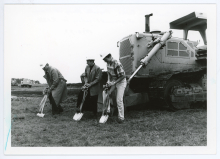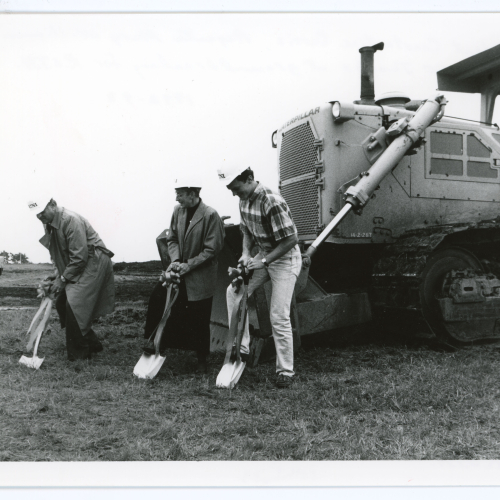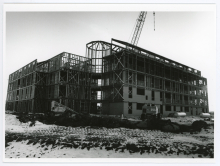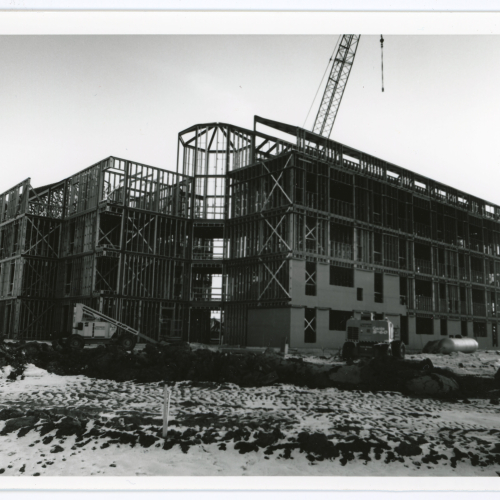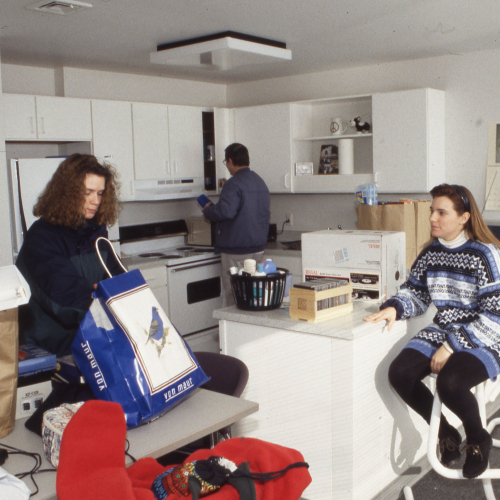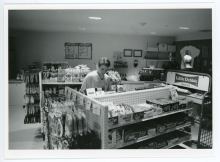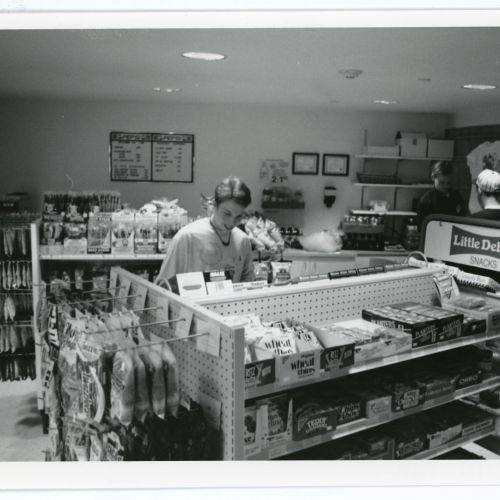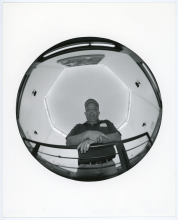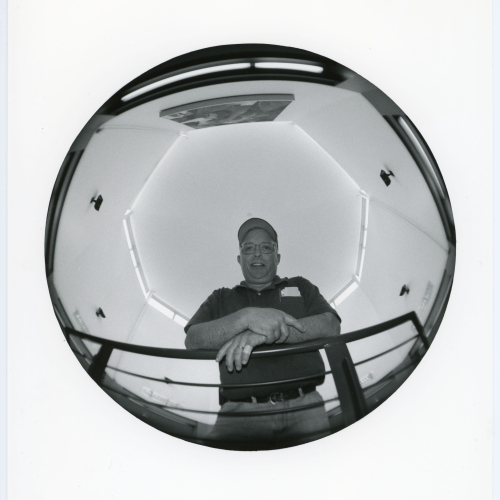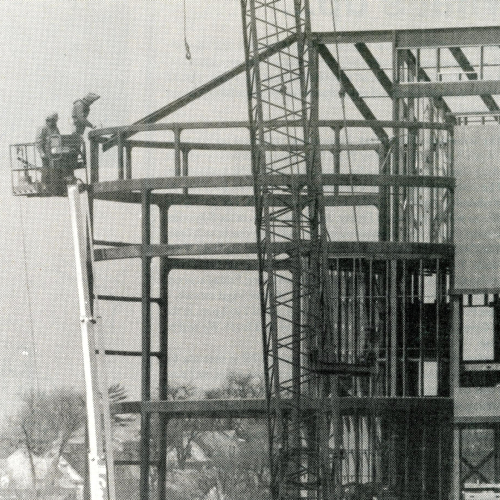Residence on the Hill (1992)
The University of Northern Iowa residence hall system underwent a period of substantial growth during the 1960s with the addition of the two Towers halls and the four Regents Complex halls. Developing these facilities was in response to the extraordinary Baby Boomer enrollment surge of those years. UNI's enrollment in 1960 was 3,616; by 1970, it had reached 9,723. Enrollment stabilized by the early 1970s. In addition, there seemed to be a decline in student interest in living in a traditional residence hall. As a result, plans for additional residence halls, such as a third high rise in the Towers Complex, were set aside.
Enrollment grew slowly but steadily during the 1980s. By the fall of 1990, the residence hall capacity of 4,555 had been exceeded by 516 students. As late as the end of the fall 1990 semester, 440 rooms were still tripled. Off-campus housing had not grown sufficiently to meet this overflow. In December 1990, the Northern Iowa Student Government passed a resolution supporting the development of a new residence hall. In January 1991, a docket item relating to crowded facilities at UNI appeared on the Board of Regents agenda, in which the university asked permission to select an architect to assist in planning a residential building, arranged in suite or apartment style, to house 300-400 students. The $6.5 to $8 million building would be financed by bonds to be paid by dormitory revenue. At that January meeting, the Regents gave UNI permission to hire a consulting firm to study the adequacy of the residence hall system to meet student needs. The Regents asked that the study consider a wide range of possibilities, including the reconversion of Baker Hall and the eastern part of Bartlett Hall to their original status as residence halls. The Regents also asked that the consultant look carefully at enrollment projections and the resultant financial projections.
For a fee of $30,000, the university hired the Des Moines architectural firm of Herbert Lewis Kruse Blunck to conduct the study. The Regents accepted the report of the consultant at their March 1991 meeting and authorized the university to search for an architect to design a plan for an apartment or suite style facility to house about 400 students. It would be located on the south side of campus. The Regents approved the project in April 1991 and asked the university to draw up schematic plans. The $8.5 million facility, which would provide separate bathrooms and kitchens for two-, four-, and six-person units, would house about 380 students. Herbert Lewis Kruse Blunck was selected as the architect. Officials hoped that the facility would be completed by the spring semester of 1993.
University housing administrators noted that the new facility might not result in the complete elimination of tripling in existing facilities. While the new facility would be able to house about 400 students once complete, that would not come close to absorbing all of the extra students in the 600 rooms that were tripled in the fall of 1991. Additionally, administrators hoped the attractive new facilities could keep upperclassmen, who might ordinarily be tempted to move off campus, within the residence hall system. If it did, that might exacerbate the overcrowding.
In October 1991, Director of Residence Clark Elmer reported to the Northern Iowa Student Government on the progress of the new facility. Elmer stated that the facility would cost $8.3 million and would house 384 students in one-, two-, and three-bedroom units. At that point, the Department of Residence had not decided on criteria to determine who would have priority in living in the new complex. Elmer hoped that the facility, the first housing units to be built on a Regents campus since 1977, would be complete by fall 1993. At its December 1991 meeting, the Regents approved the sale of $9.14 million in dormitory revenue bonds. Due to its excellent bond rating, UNI received a low rate of 6.05 percent on the sale.
By August 1992, contractors had fenced off the site in the southeast corner of campus in preparation for construction. Story Construction Company of Ames was the general contractor. A groundbreaking ceremony was held September 21, 1992. The usual dignitaries took part in the ceremony, but all students were invited to turn a spade of earth as well. The new completion date was set for January 1994. At the ceremony, President Curris said:
“This single event is special because this new hall has been designed for students and in large majority by students…It is part of an unfolding panorama of programs and people which gives UNI distinction and favor now and for decades to come."
In commenting on the new facility, Clark Elmer said, "The new residence hall is designed to meet the changing needs of our students…It focuses on the need for greater privacy, as well as opportunities for continuing social and intellectual interaction. Our goal is to create a hybrid residence hall/apartment experience.” The four wings of the facility would be centered around a commons area with a laundry, convenience store, recreation space, office, and mail room. Two of the wings would consist of suites and two wings would consist of apartments. Construction progressed steadily, so that by March 1993, the framing was in place, with exterior brickwork to begin soon. However, heavy rains and floods in 1993 slowed the work. By September 1993, Director of Facilities Planning Morris Mikkelsen said that a month or two had been lost due to the weather. He hoped that at least some of the units would be complete by January 1994 but that in all likelihood the facility would be phased in as units were finished.
By then, the Department of Residence decided that residents would be limited to sophomores, juniors, and seniors, with priority given to those students who had resided in the residence hall system the longest. At the same time, ideas began to surface for naming the facility. Northern Iowa Student Government Senator John Flint suggested naming the facility in honor of John Eiklor, a beloved professor of history and the humanities, who died in 1992. NISG adopted a resolution and over 2,000 students signed a petition supporting this suggestion. Ultimately, the facility came to be known as the “Residence on the Hill,” or “Roth.” By the beginning of the spring 1994 semester, Units C, D, and E were open and about 100 students were able to move into the new halls. Units A and B would be completed by the end of the semester.
Clark Elmer said, "It isn't a 'cookie cutter' design" and praised the variation in its room arrangement. Initial rates ranged from $800-$1,100 per person, for a double occupancy bedroom, to $1,008-$1,496 per person, for a single occupancy bedroom. Most residents enjoyed the new living arrangements and the change from the traditional residence halls. Several, however, did comment on the relatively longer walk to campus.
The residence complex was plagued early on by hard water deposits in the water heating system. There were times when the complex was without hot water for several days. By February 1995, Northern Iowan writer Tim Manuel devoted an entire humorous column to describing, and mostly praising, life in the complex. He made light of his own cooking abilities and noted problems with the heating and hot water systems, but he enjoyed the privacy living there afforded him. Contrasting life in Roth Apartments with life in traditional dormitories, he wrote, "Believe it or not, you eventually tire of sharing a bathroom with 50 other people."
On November 11, 1995, the four halls which make up Roth Apartments were dedicated to honor four UNI faculty members. The units would be known as Eiklor Hall, Holmes Hall, McGovern Hall, and Pendergraft Hall. Eiklor Hall is named for John Eiklor, a professor of history and a master teacher, who taught at UNI from 1963 through 1992; Holmes Hall for Mavis Holmes, Dean of Students from 1958 through 1972 (Dean Holmes is credited with developing the current residence system on campus); McGovern Hall, is named in honor of Anna McGovern, a member of the Class of 1881 and one of the first women on the faculty. She taught at UNI from 1881 through 1919 and was a favorite of generations of UNI students; and finally, Pendergraft Hall is named for Daryl Pendergraft, a professor of history from 1946 through 1975, who also held several high-level administrative positions.
Over the years, Roth Apartments residents have developed services and programs to meet their particular needs. The complex has also offered opportunities for "focus communities," groups of living units which would foster learning or studying a particular subject, skill, or topic. While the relative isolation from central campus has fostered a greater sense of independence it can also mean long, cold walks in the winter. Consequently, at least during the cold seasons, shuttle bus service has been available for students. The relative isolation of Roth Apartments also led to the installation of emergency phones and security cameras in the area in 2002.
Roth Apartments continue to appeal to students who want the community of residence hall life with the independence of living in an off-campus apartment.
Originally compiled by Library Assistant Susan Witthoft; edited by University Archivist Gerald L. Peterson, September 1996; substantially revised by Gerald L. Peterson, with research assistance by Emily Candee and Julie Wiese and scanning by Library Assistant Gail Briddle, February 2003; last updated, February 9, 2012 (GP); photos and citations updated by Graduate Assistant Eliza Mussmann March 29, 2023; content updated by Graduate Intern Marcea Seible, June 2025.

